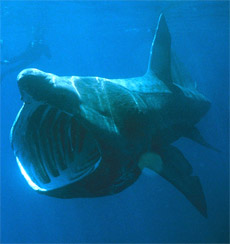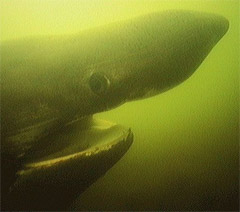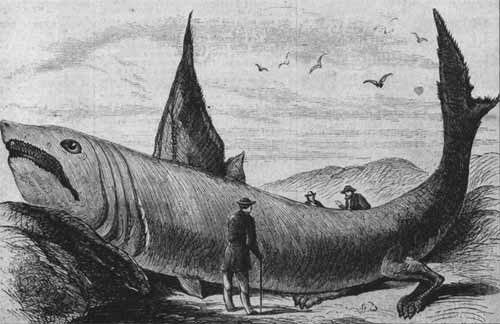|

 Sizes and Scales: Reported to reach a weight of six tonnes and maximum length of 15.2 metres (50 feet), but most Sizes and Scales: Reported to reach a weight of six tonnes and maximum length of 15.2 metres (50 feet), but most
often recorded at up to four tons and 9.8 metres (32 feet), Basking Sharks are one of the classic "sea monsters" of old.
Not Just a Pretty Face: These sharks have been mistaken for Great White Sharks: the two species can be easily distinguished, however, by the Basking's cavernous maw (up to a metre in width, held wide open whilst feeding), longer and more obvious gill slits (which nearly circle the entire head and are accompanied by well-developed gill rakers), smaller eyes, and usually smaller girth.
Telling Teeth: Also, Great Whites possess large, dagger-like teeth, whilst those of the Basking Shark are greatly reduced (5-6 mm) and hooked; only the first 3-4 rows of the upper jaw and 6-7 rows of the lower are functional.

 Basking in the Sun: Basking sharks are so named for their apparent basking behavior while feeding. They are most often seen while basking at the surface with their mouths open. Basking in the Sun: Basking sharks are so named for their apparent basking behavior while feeding. They are most often seen while basking at the surface with their mouths open.
Filter Feeders: The Basking shark is a filter feeder eating plankton from the water with its wide, gaping mouth. Unlike the Megamouth Shark and Whale Shark, Basking Sharks do not appear to actively seek their quarry, but do possess large olfactory bulbs that may point the sharks in the right direction.

Birds and the Bees: Basking Sharks are ovoviviparous: the developing embryos first rely on a yolk sac, and as there is no placental connection, they later rely on unfertilized ova produced by the mother (a behaviour known as oophagy). Gestation is thought to span over a year (but perhaps much longer), with a small and unknown number of young born fully developed at 1.5-2 metres (5-6.5 feet) in length. Mating is thought to occur in early summer and birthing in late summer, following the female's movement into shallow coastal waters.
The onset of maturity in Basking Sharks is not known with certainty but is thought to be between the 6-13th year of life and at a length of between 4.6-6 metres. Breeding frequency is also unknown, but is thought to be 2-4 years.
Useless Teeth: The seemingly useless teeth of Basking Sharks may play a role in courtship behaviour, possibly as a means for the male to keep hold of the female during mating.

All text is available under the terms
of the GNU Free Documentation License
|